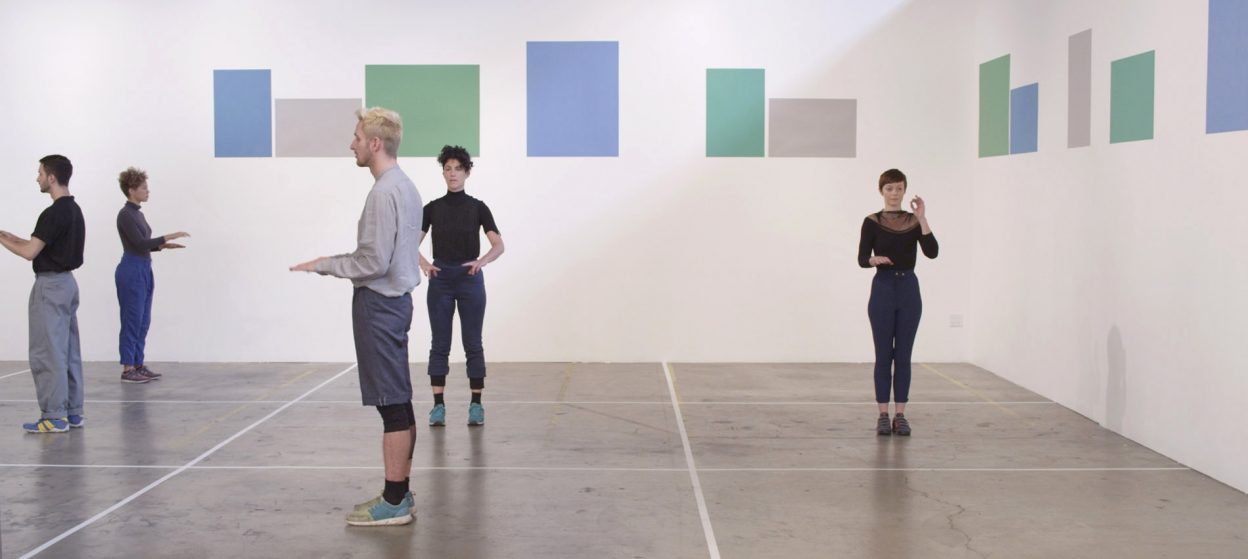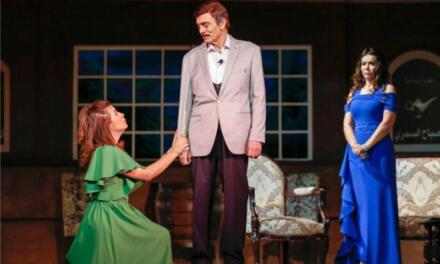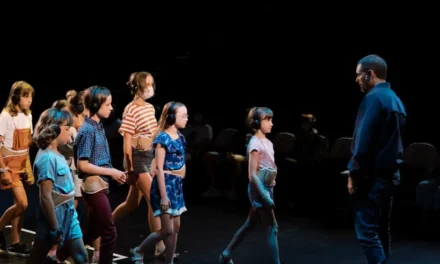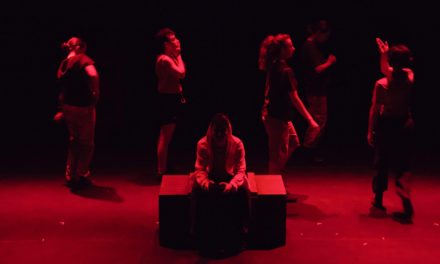For Part I, click here.
For many visual artists working in performance, it is theater’s formality and the conventions of the stage that compel them to work outside of it. Visual artist Julie Bena—on whose Have You Seen Pantopon Rose? I am currently working as choreographer and performer—was a child actress raised in a theatrical household. Bena might employ a script, professional actors, and even a theatrical mise-en-scène in her performances, but says that trying to mount her work in a theater feels completely inhibitive and “heavy,” attributing this in part to the elitism of French theater. While some cultural legacies may be more stubborn than others, it occurs to me that what is also “heavy” about the stage is the responsibility to use it. What I mean is that, to a theater artist, the conventions of the stage are not simply limitations, but the concrete possibilities for creation in that theater which utilizes their power, where the stage facilitates a commune between the audience and the theatrical event. The stage is not a cage. What Bena’s feelings about the stage tell me is that, unlike the unfortunate number of commercial theater artists relying strictly on naturalism, she lacks the arrogance to pretend that the enormous weight of the stage does not exist.
Beyond performance ideology, we can identify strategic advantages of dissociating from theater—for artists and experimental theater directors alike. All artists must find our way to leverage the opportunities available to us, and, frequently, the contemporary art economy can offer far more support and programming opportunities for performance than the theater economy affords to progressive work on its stages. This is partly because of the cost of mounting work in theaters but at the same time, undeniably, “white-box” performance has become very fashionable. Bizarrely, visual artists are widely afforded the opportunity to create performances with the support of major institutions despite having little or no experience, while I imagine the criteria upon which a museum might decide to exhibit the amateur painting of even a well-known theater artist are quite different. The beauty of this trend is, of course, that it creates more opportunities for visual artists and performing artists alike. Its detriment is how it undermines theater mastery, and generates the damaging anti-theater rhetoric upon which some artists build their brands, which amounts to “My work is art, not theater. Art is better than theater.” Parisian theater artist Vincent Thomasset, for example, seems to have been quite successful in branding himself as an artist creating performance works that happen to take place on a stage, rather than as a theater artist per se. Thomasset’s Bodies in the Cellar, a stage work based on The Glass Menagerie, uses highly skilled performers and employs an array of sophisticated theatrical tactics to deconstruct the classic text. Yet Thomasset doesn’t call it theater at all. Rather, he asserts: “I use the same tools that we can find in theater, but I get away from them immediately.” What is not obvious is the unfortunate fact that Thomasset may be not so much of an opportunist as a survivalist. Nevertheless, the perpetuation of his rhetorical game is ultimately harmful to the theatre, and reinforces the misplaced idea that only non-theater artists can create something original and interesting in today’s performance spectrum.
The reality is that having a background outside theatre in no way predisposes a visual artist to create something new or sophisticated in performance or theater. While indeed there are visionary theater and performance artists in any combination of theater or non-theater disciplines, what may be gained by an innocence of theatrical conventions can just as easily be countered by an ignorance of them. An artist in the infant stages of discovering performance, lacking knowledge of or indifferent to theatrical pedagogy, is just as susceptible to mistaking the most basic and unsophisticated ideas of theater for something new and relevant as transcending them. When the large-scale opera Semele was put in the hands of Chinese artist Zhang Huan at BAM in 2015, described by one critic as “a mishmash of wilful oddness and unimaginative conventionality,” it begged the question of why a major cultural institution like BAM would throw itself at someone so under-qualified on a first date. Perhaps even in the world of the performing arts, we are witnessing the ascendance of the singular artist and the idea heralded over all else.
Increasingly, visual artists keen to venture into performance can get the valuable production experience they need through interdisciplinary initiatives at various performing arts institutions. On the artists’ own agency, too, performance collaborations can be fostered in a way that shares practices and develops new ones, deepens the work, and eliminates exploitation by educating and empowering the artist. In a practical sense, I’ve been baffled by how some artists spend years in the studio learning any number of other techniques and yet take no time to understand the possibilities and limits of our bodies and voices. If an artist intends to capitalize on our skills, the more he or she understands those skills, the more likely it is that we will be well-used rather than just used. Neglecting theatrical principles is a sure-fire way for actors and dancers to end up directors and choreographers by default, left to solve the variables of time and spatial dynamics, arc, flow, rhythm, and how movement and presence leverage energy. Ignoring these things doesn’t mean they cease to exist. There is no performance without spatial relationship; its use of space is merely poor or good. There is no performance that exists out of time; its use of time is merely poor or good. That is, “poor” versus “good” in terms of the realization of the artist’s intended vision as it relates to the real-time variable of the performer-spectator experience. And something that is frequently taken for granted is the theater artist’s well-honed sensitivity to this relationship.
My intention is not to reclaim performance as theater. The majority of theater artists would draw a line between the two with great conviction, and it is often the quality of this unquantifiable, real-time contribution of the actor that is at the heart of the distinction. In his book, Culture Is The Body, theater director Tadashi Suzuki describes the extraordinary encounter between actor and audience as theater’s defining element: The actor’s cozening produces a dense space where the seer and the seen, at first structurally separated and estranged, coalesce into one. The instant this fusion of actor and audience is achieved, theatre is born.” However, it is not, I would argue, the absence of this “cozening”, as Suzuki calls it, that helps us distinguish a performance from theater, simply because we cannot be sure of its absence. No matter how the actor is re-contextualized, who can say if the actor’s cozening is taking place with or without the artist’s intention? Philosopher Alain Badiou passionately maintains what sets theater apart from performance is theater’s unique ability to make an idea imminent through the body’s potential, combined with its willingness to express the realm of thought as emotions. In other words, he affirms that representation is the device of theater that performance historically avoids.
In my experience as a performer, I would also attribute to theater the spontaneous “genius” of the cozening Suzuki describes, simply because a performance’s presentation as a fixed art object is counter to this. For a work to be presented alongside paintings and sculptures, and certainly to be bought and collected, it seems the work must, essentially, remain the same in repetition, whether in the execution of its physical actions, as in WSWDN?, or in its dramaturgy (meaning not script analysis but the active interrogation of context and meaning). With the presentation of a fixed object, there must be a halting of dramaturgy, and so the potential for the performer’s revelation or reinvigoration has ended once performances begin. Theater is ephemeral, with no two performances expected to be the same. Even in the highly sculpted work of a visual theater artist like Robert Wilson, I would argue that formal specificity does not mean a director stops demanding genius of his performers—that is, the ability to not only create a space that transcends quotidian reality (cozening) but to use each performance to continually invite discoveries about the work, even if through barely detectable adjustments.
Ultimately, I find these arguments compelling but incomplete, and believe what distinguishes my art from performance will be articulated uniquely by each theater and visual artist herself. Nevertheless, the talk of cozening and audience, leads me to ask: What of the spectator? Is it not what a gallery audience should expect, for performances to be viewed like one would a painting or a sculpture—to choose to tune into it at will as they converse with friends and check their cell-phones? If not, if a work demands a different kind of spectatorship—a different kind of focused attention in time—as, I would argue, performance works often do, perhaps, would it be reasonable to prepare the audience for what they are about to see, perhaps then, even making use of the word theater? For I’ve never, not once, turned up to see a play and been surprised to instead find only a painting hung onstage and no actors. Aside from the lack of actors and action, there would be no dynamic, interrelated use of space and time. So, can we call it a play, that painting on the stage? And is spectatorship and the expectations therein, especially regarding the use of time, a factor in the answer? (This scenario is extremely helpful in understanding the dullness of a gallery performance where an artist has completely ignored the theatrical skills he would have needed to employ to manipulate bodies, time and space in the same way he mastered his plastic arts. The result, in terms of audience experience, becomes the equivalent of placing a painting on a stage.)
It certainly creates obstacles when presenting institutions manage us like the unwieldy materials of an annoyingly expensive and complicated, albeit fashionable, art object instead of theater artists. Even top institutions can be ignorant of standard performer fees; in New York, when I hear a modestly funded commission to theater artists by the Metropolitan Museum of Art bolstered as an “uptown-downtown collaboration” (“downtown” referring to the city’s historically under-funded experimental theater scene), it can only be seen as excusing poor pay. And those that regularly present live work with a specialized staff to manage it still don’t seem to fully grasp that showing a live work involves the real-world cost and production efforts of employing performers to execute it. Performance art curators volleying between production roles by default could easily consult theatrical production to reform their performer contracts and procedures or, better yet, employ theatrical production staff to manage performance, for which we’d be happy to provide references. For now, we surely cannot take for granted our compensation or safety, let alone our due credit.
Nevertheless, theater artists like myself continue to be compelled by the art world in one way or another. As visual artists seek inspiration, tools and capable bodies for realizing performance, we too seek interdisciplinary dialogue and pursue the potential for a complete theater through the creative intelligence of other arts. My own theater project, a director-composer alliance with sound artist Yiannis Christofides, stakes its foundation upon the marriage of the plastic arts with stagecraft. Hans-Thies Lehmann quotes theater director Heiner Goebbels on his own approach: “I am interested in inventing a theatre where all the means that make up theatre do not just illustrate and duplicate each other but instead all maintain their own forces but act together, and where one does not just rely on the conventional hierarchy of means…” This idea of non-hierarchy, of working towards a simultaneity of elements and thus resisting the traditional subordination of one part of theater-making to another, is more than performance ideology. In response to the art world and its creative colonization, to the anti-theatricalism that claims to make theater obsolete while capitalizing upon it, I put forth non-hierarchy as an alternative to individualism and market-driven ethics. When I speak in defense of my “endangered” art, I am not only convinced of theater’s continued relevance, its inherent power to address the struggles of our times, I am proud of theater’s tradition of collaboration and community. Looking more closely at collaborative art-making not only reinforces theater’s enduring value, it reveals the absurdity of an over-bearing celebration of the singular artist.
This post was written by the author in their personal capacity.The opinions expressed in this article are the author’s own and do not reflect the view of The Theatre Times, their staff or collaborators.
This post was written by Kestrel Leah.
The views expressed here belong to the author and do not necessarily reflect our views and opinions.


















